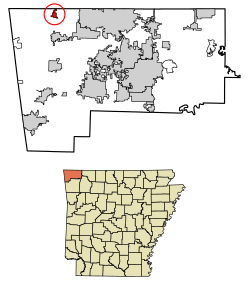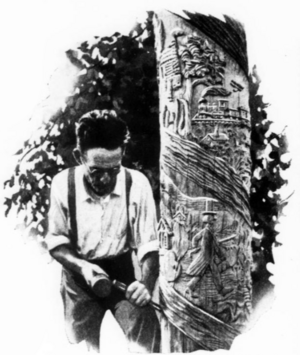Sulphur Springs, Benton County, Arkansas facts for kids
Quick facts for kids
Sulphur Springs, Arkansas
|
|
|---|---|

Location of Sulphur Springs in Benton County, Arkansas.
|
|
| Country | United States |
| State | Arkansas |
| County | Benton |
| Area | |
| • Total | 1.01 sq mi (2.63 km2) |
| • Land | 1.01 sq mi (2.62 km2) |
| • Water | 0.00 sq mi (0.01 km2) |
| Elevation | 909 ft (277 m) |
| Population
(2020)
|
|
| • Total | 481 |
| • Density | 475.77/sq mi (183.78/km2) |
| Time zone | UTC-6 (Central (CST)) |
| • Summer (DST) | UTC-5 (CDT) |
| ZIP code |
72768
|
| Area code(s) | 479 |
| FIPS code | 05-67760 |
| GNIS feature ID | 2405541 |
Sulphur Springs is a small city located in Benton County, Arkansas, in the United States. In 2020, about 481 people lived there. It is part of the larger Northwest Arkansas area.
Contents
History of Sulphur Springs
Sulphur Springs began in 1885 as a special place where people could visit mineral spas. These spas were popular because people believed the mineral-rich water had health benefits.
Geography and Natural Springs
Sulphur Springs is in the northwest part of Benton County. The city center is about one mile south of the border with Missouri. Arkansas Highway 59 goes through the city. It leads north to Noel, Missouri, and south to Gravette. The city covers about 1.01 square miles (2.6 square kilometers) of land.
The Ozark Highlands and Springs
Sulphur Springs is located in the Springfield Plateau subregion of the Ozarks. This area has rocks that let rainwater easily soak into the ground. This water then flows underground into areas called aquifers. When this underground water comes to the surface, it forms a spring.
The springs in Sulphur Springs are special because they contain many different minerals. Historically, these springs were named after the main mineral found in their water:
- Black sulphur: Water with a gas called hydrogen sulfide. This gas reacted with metals like iron to create a dark substance.
- Chalybeate: Water that has a lot of iron salts, especially a type called ferrous bicarbonate.
- Lithium salts: A rare type of mineral water that contains lithium.
- Magnesia: Water with a high amount of magnesium, often in the form of magnesium carbonate.
- Nitre: Water rich in potassium nitrate, also known as saltpeter.
- Potash sulphur: Water that contains both potassium and sulfur.
- White sulphur: Water with a lot of sulfur compounds, especially hydrogen sulfide gas and sulfates. "White" meant the water was clear and colorless.
Ozark Colony: A Creative Community
Ozark Colony was once a separate community near Sulphur Springs. Today, it is a neighborhood within the city.
Starting a Unique Community
In 1921, a retired oilman named Walter R. Eaton started Ozark Colony. He invested $25,000 (which would be about $436,200 today) to create a special place. It was designed as a cooperative for people who loved art and learning. People could buy land plots and work together on community projects. The money they earned from these projects helped pay for their vacations at the colony.
Activities and Creations
The people in Ozark Colony worked in a large 100-acre (40.4 ha) vineyard. This vineyard was owned by a group called the Ozark Colony Grape Club. They used the grapes to make juice and marmalade, which they sold. They also made furniture from hickory wood and had a poultry (chicken) club. Walter Eaton also worked with other nearby tourist towns, like Eureka Springs, to help sell the handmade products from the colony.
The colony had more than 40 small houses, called cottages. It also had a Greek-style theater where classical music and plays were performed. There was a lodge with a dance floor and a disco ball. For fun, there were manmade lakes stocked with trout for fishing, tennis courts, and a swimming pool. During different seasons, the colony hosted art shows and art classes. Famous artists from the Kansas City Art Institute would visit to teach. Music classes and plays were also common.
Art and Artists of Ozark Colony
Jim Sease, an artist and cabinet-maker who lived in the colony, created a totem pole. Totem poles were popular in tourist areas at the time. His totem pole told the story of the community. It showed a general nod to Native Americans, the four mineral springs of Sulphur Springs, and symbols for the railroad and airplanes. It also included images of a modern city with hotels and John Brown University.
Another artist, John Eliot Jenkins, had his studio in the colony. His paintings can now be found in state capitol buildings and libraries in many states, including Kansas, Missouri, Oklahoma, Texas, and Virginia. His painting Snow in the Ozarks (1925) is part of the collection at the Arkansas Museum of Fine Arts in Little Rock, Arkansas.
Population of Sulphur Springs
| Historical population | |||
|---|---|---|---|
| Census | Pop. | %± | |
| 1900 | 315 | — | |
| 1910 | 500 | 58.7% | |
| 1920 | 470 | −6.0% | |
| 1930 | 404 | −14.0% | |
| 1940 | 435 | 7.7% | |
| 1950 | 543 | 24.8% | |
| 1960 | 460 | −15.3% | |
| 1970 | 503 | 9.3% | |
| 1980 | 496 | −1.4% | |
| 1990 | 523 | 5.4% | |
| 2000 | 671 | 28.3% | |
| 2010 | 511 | −23.8% | |
| 2020 | 481 | −5.9% | |
| U.S. Decennial Census | |||
In 2020, the city of Sulphur Springs had 481 residents. The average age of people living there was about 34.5 years old. Most people in Sulphur Springs drive alone to work, but many also carpool or work from home.
Education in Sulphur Springs
Students in Sulphur Springs attend schools in the Gravette School District. This district includes Gravette High School.
Places to Visit
- Old Spanish Treasure Cave
- Sulphur Springs Park Reserve
Notable People
- Jim Hendren (born 1963) is a businessman from Sulphur Springs. He has served as a representative in the Arkansas House of Representatives and currently represents District 2 in the Arkansas Senate.
See also
 In Spanish: Sulphur Springs (condado de Benton) para niños
In Spanish: Sulphur Springs (condado de Benton) para niños


